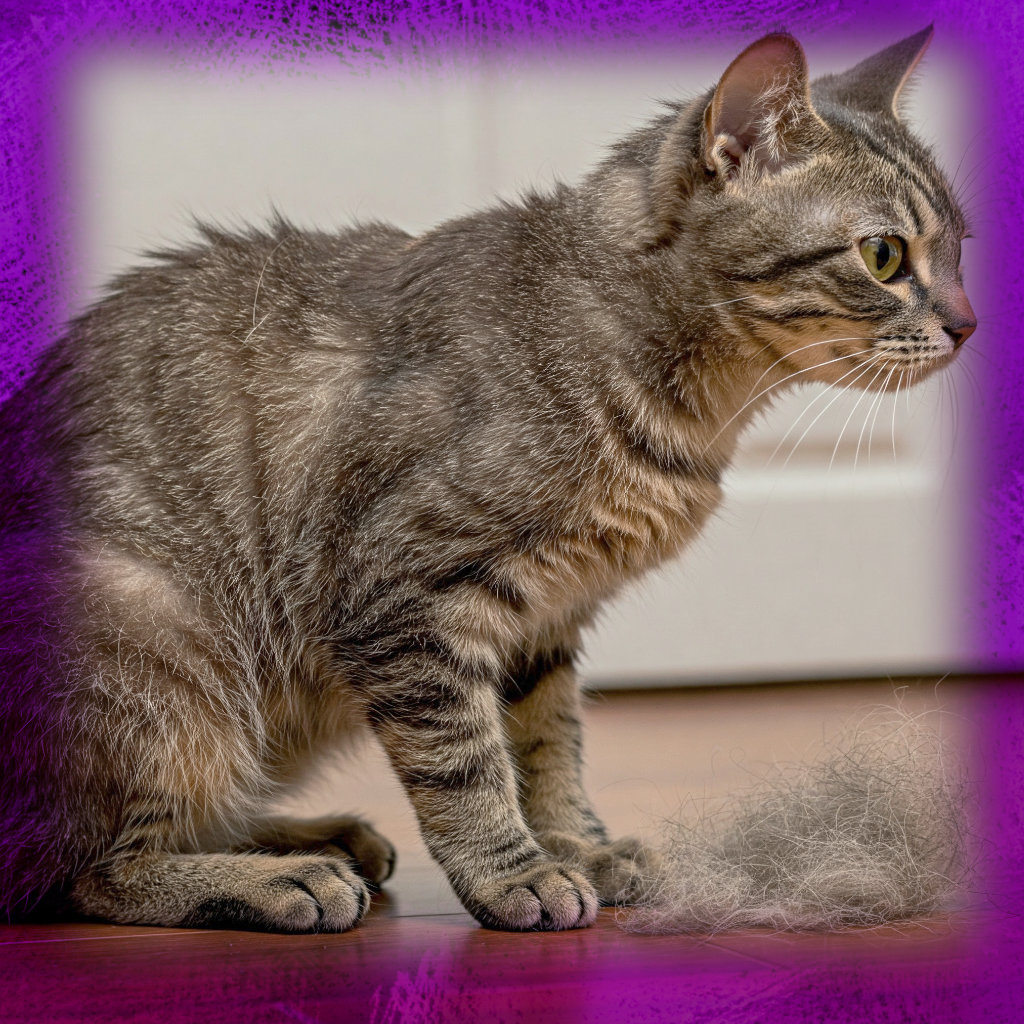Understanding Your Cat’s Hair Loss Problem
Discovering clumps of fur around your home or noticing thinning patches on your cat’s once-luxurious coat can be alarming. While shedding is normal, excessive hair loss often indicates an underlying health issue requiring attention. This comprehensive guide examines all potential causes, from common seasonal shedding to serious medical conditions, helping you identify and address your feline companion’s hair loss effectively.
Normal Shedding vs. Problematic Hair Loss: Knowing the Difference
All cats shed – it’s a natural process of renewing their coat. However, there’s a significant difference between healthy molting and concerning alopecia (the medical term for hair loss). Normal shedding:
- Occurs evenly across the body
- Maintains coat density
- Follows seasonal patterns (typically spring and fall)
- Doesn’t cause visible skin irritation
Problematic hair loss presents differently:
- Creates bald patches or uneven thinning
- Shows accompanying skin changes (redness, scabs)
- Occurs outside normal shedding seasons
- May change your cat’s grooming behavior
The 10 Most Common Causes of Feline Hair Loss
1. Seasonal Coat Changes
Twice annually, most cats undergo significant molting. In spring, they shed heavy winter coats; in fall, they prepare for colder weather. Long-haired breeds like Maine Coons and Persians experience more dramatic sheds. This natural process shouldn’t cause concern unless hair isn’t regrowing normally.
Management Tips:
- Increase brushing frequency during peak shedding seasons
- Use deshedding tools for long-haired cats
- Ensure proper hydration to support skin health
2. Stress-Induced Overgrooming (Psychogenic Alopecia)
Cats are sensitive creatures, and stress can manifest physically through excessive grooming. Common triggers include:
- New pets or family members
- Changes in routine
- Moving homes
- Loud noises (construction, thunderstorms)
This compulsive licking creates symmetrical bald areas, typically on the abdomen, inner thighs, and forelegs. Unlike medical causes, these patches rarely show inflammation unless secondary infection occurs.
3. Flea Allergy Dermatitis
The most prevalent parasitic cause of feline hair loss isn’t the fleas themselves, but an allergic reaction to their saliva. Even a few bites can trigger intense itching, leading to:
- Violent scratching
- Hair loss along the back and tail base
- Small scabs (miliary dermatitis)
- Secondary skin infections
Critical Note: You may never see the fleas, as cats are efficient groomers who often remove the evidence.
4. Other Parasitic Culprits
Several microscopic pests can cause hair loss:
- Demodex mites: Cause patchy hair loss and scaling
- Cheyletiella mites: Create “walking dandruff” appearance
- Ear mites: Lead to hair loss around ears from scratching
5. Environmental Allergies (Atopy)
Like humans, cats can develop allergies to:
- Pollens
- Dust mites
- Mold spores
- Household cleaners
These typically cause:
- Face and ear itching
- Hair loss from excessive scratching
- Recurrent ear infections
- Paw licking
6. Food Allergies and Sensitivities
Common protein sources like beef, dairy, and fish frequently trigger allergic reactions. Symptoms include:
- Chronic ear inflammation
- Gastrointestinal issues
- Hair loss around the face and neck
- Full-body itching
Diagnosis requires an 8-12 week elimination diet under veterinary guidance.
7. Hormonal Imbalances
Endocrine disorders often cause symmetrical hair loss:
- Hyperthyroidism: Causes thin, greasy coat with weight loss
- Cushing’s disease: Leads to fragile skin and hair loss
- Diabetes mellitus: Can cause poor coat condition
These conditions require blood tests for diagnosis and typically need lifelong management.
8. Nutritional Deficiencies
Poor diet leads to:
- Dry, flaky skin
- Dull, brittle fur
- Excessive shedding
Essential nutrients for coat health include:
- High-quality animal proteins
- Omega-3 fatty acids
- Zinc
- B vitamins (especially biotin)
9. Ringworm (Dermatophytosis)
Despite its name, this fungal infection creates:
- Circular patches of hair loss
- Broken hairs at lesion edges
- Sometimes mild scaling
- Potential for human transmission
Diagnosis requires fungal culture or Wood’s lamp examination.
10. Bacterial and Yeast Infections
Secondary infections often complicate primary causes of hair loss:
- Staphylococcus: Causes pustules and crusting
- Malassezia yeast: Leads to greasy, smelly skin
These typically require cytology for diagnosis and specific antimicrobial treatment.
Diagnosing the Cause: What to Expect at the Vet
When you bring your cat in for hair loss, your veterinarian will likely:
- Take a detailed history:
- When the hair loss began
- Any changes in environment or diet
- Grooming behavior changes
- Other symptoms noticed
- Perform a physical examination:
- Pattern and distribution of hair loss
- Skin condition beneath lost hair
- Presence of parasites
- Overall health assessment
- Recommend diagnostic tests which may include:
- Skin scrapings for mites
- Fungal cultures for ringworm
- Blood tests for hormonal conditions
- Allergy testing
- Skin biopsies in persistent cases
Treatment Options Based on Cause
For Parasitic Causes:
- Prescription flea preventatives
- Medicated shampoos
- Environmental decontamination
- Antibiotics for secondary infections
For Allergic Causes:
- Allergen-specific immunotherapy
- Novel protein or hydrolyzed diets
- Anti-itch medications
- Essential fatty acid supplements
For Behavioral Causes:
- Environmental enrichment
- Anti-anxiety medications if needed
- Synthetic pheromones (Feliway)
- Behavior modification techniques
For Hormonal Causes:
- Thyroid medication
- Insulin for diabetes
- Specialized treatments for Cushing’s
For Nutritional Causes:
- Premium, balanced diets
- Omega-3 supplements
- Probiotics for gut health
Preventing Future Hair Loss Problems
- Establish a grooming routine:
- Daily brushing for long-haired cats
- Weekly brushing for short-haired cats
- Regular nail trims to prevent skin damage from scratching
- Provide optimal nutrition:
- High-quality protein sources
- Appropriate fat content
- Limited unnecessary carbohydrates
- Maintain parasite prevention:
- Year-round flea control
- Regular deworming
- Environmental management
- Reduce household stress:
- Consistent routines
- Vertical space for climbing
- Multiple litter boxes in multi-cat homes
- Quiet retreat spaces
- Schedule regular veterinary checkups:
- Annual exams for young cats
- Biannual exams for seniors
- Prompt attention to any coat changes
When to Seek Emergency Care
While most causes of hair loss aren’t immediately life-threatening, contact your vet immediately if you notice:
- Sudden, widespread hair loss
- Open, bleeding sores
- Signs of pain or lethargy
- Loss of appetite accompanying hair loss
- Any signs of systemic illness (vomiting, diarrhea, difficulty breathing)
The Prognosis for Hair Loss Conditions
Most causes of feline alopecia respond well to treatment when addressed promptly. Key factors affecting recovery:
- Early intervention leads to better outcomes
- The underlying cause determines treatment duration
- Secondary infections may complicate recovery
- Chronic conditions may require lifelong management
With proper care, the majority of cats regrow their coats fully, though some may have minor permanent changes in texture or color.
Final Thoughts
Your cat’s coat serves as both protection and a health barometer. While finding excess hair around your home can be concerning, understanding the potential causes empowers you to seek appropriate care. Remember that prompt veterinary attention provides the best chance for complete resolution of hair loss issues. By combining professional guidance with attentive home care, you can help your feline companion maintain a healthy, beautiful coat throughout their life.

